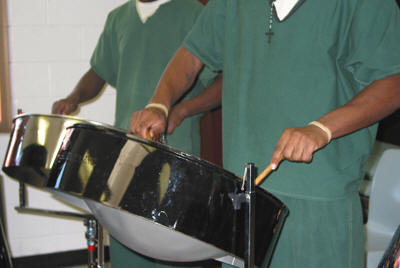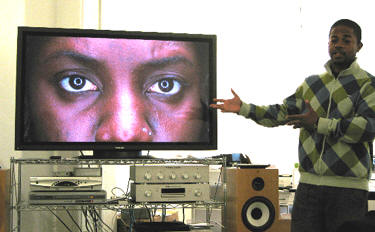Dale Davis

Steel drum band at the Monroe County Jail
(Photo: Dale Davis)
|
What is failure when we integrate the arts into correctional education? The question was posed to me and others during a steering committee meeting of the newly-formed New York State Arts In Correctional Education Network by John Curtis, Assistant Principal of Austin H. MacCormick Island Academy on Rikers Island. The network, an outgrowth of arts organizations and educational providers who work with incarcerated adolescents, came together this year with funding from the New York State Council on the Arts (NYSCA) to gather information on the arts in correctional education throughout the state.
We are working together to develop a support community and a network of resources to facilitate dialogue and collaboration among arts organizations, artists, and correctional education programs, and to support artists and arts organizations with the knowledge and training needed to better serve correctional education. Doing so requires looking at the effects of arts integration in incarcerated programs: how do we know if arts integration changes anything and how do we measure results.
Curtis� question on what failure means when the arts are brought to correctional education came immediately to mind when I received the following email from a participant in the New York State Literary Center�s Empire State Partnership (ESP) named Jon.
I was in Monroe County Jail when we met. I�m not sure if you remember me, but I just wanted you to know I am doing well right now. I�m still writing poetry, and I want to keep up with you about writing poetry. But in this e-mail I want to let you know I�m going back to school. School is putting pressure on me, but I know I have to do it for my future. I just want to say how thankful I am for everything you did for me in jail.
While incarcerated, Jon discovered something he liked to do and could do well. He is now not afraid to say he wants to succeed in school, and he lives with all the pressures of school for an adolescent who is returning following incarceration. He had a need to say �thank you.� Is Jon�s case a success, and how should success be measured?
In a poem Jon emailed me later, he used writing to address what he knows now is necessary to succeed. In his poem he did what award-winning American writer Jimmy Santiago Baca writes about. Baca, who was incarcerated at 19 years of age, wrote in his 2002 memoir A Place To Stand:
Language gave me a way to keep the chaos of prison at bay and prevent it from devouring me; it was a resource that allowed me to confront and understand my past, even to writing from it some compelling truths, and it opened the way toward a future that was based not on fear and bitterness or apathy but on compassionate involvement and a belief that I belonged.
Baca�s writing is a touchstone in my work in Arts, Literacy, and the Classroom Community (ALCC), the New York State Literary Center�s ESP with Rochester City School District�s Youth and Justice Programs, in collaboration with the Office of The Sheriff, County of Monroe. This is the third year of our NYSCA-funded ESP. The Rochester City School District�s Youth and Justice Programs educate students who are detained in Monroe County. ALCC serves incarcerated youths between 15 and 18 who have been tried and convicted as adults and are serving sentences of one year or under, as well as those between 15 and 18 who have been arrested and are awaiting trial at the Monroe County Jail or the Monroe County Correctional Facility.
The students participating, on average, have reading and math skills between 3rd and 6th grades. They have been truant, experienced retention, been classified with learning disabilities, behavioral disorders, and have many socio-economic needs. Most are from homes with one parent, homes where one parent is incarcerated, and homes where one or both parents are involved in drug abuse and/or illegal activities and abuse. Most have witnessed shootings and have lost friends and relatives to violence; they have grown up in an environment of poverty and violence.

Chris "Kazi" Rolle at screening of The Hip Hop Project
For the NYS Arts In Correctional Education Network
(Photo: Michael Starenko)
|
The greatest challenge ALCC faces is motivating adolescents at the highest risk of educational failure, a population whose circumstances, I believe, require programs designed to meet unique and individual needs. The educational system has not worked for these students. Recent research from the US Department of Justice shows that more than two of three high school offenders do not return to school and that attaining a high school diploma is the strongest deterrent to re-arrest. The research recommends a dual curriculum that builds students� academic and social skills and includes literacy activities as a natural component. A study by the Youth Justice Board (2005) recommends that programs focus on what the adolescents are passionate about, an interest-based, student-centered curriculum designed to motivate. In response to the challenges identified by research, ALCC develops such interest-based, student-centered arts integrated strategies to motivate reluctant learners through culturally relevant programs that increase the students� academic engagement. Students have watched a screening of The Hip Hop Project with the film�s star, Chris �Kazi� Rolle, as well as Black Ice and Def Poetry Jam on DVD. They have listened to and discussed the music of Tupac Amaru Shakur, Nas, Jay-Z, and Talib Kweli. They have written and performed poetry and and have learned to compose music for their writing and recording their writing and music for a CD, to performing in a steel drum band. How is the students� academic engagement in these strategies measured?
It is difficult to monitor the progress of ALCC�s transient population. Length of stay is determined by the justice system. Student work is constantly published and reviewed to show where the students are and what they are doing. By documenting the experiences of students we begin to give a clearer picture of the students� attendance, ability to make positive choices, academic engagement, follow-through on assignments, use of language, classroom behavior and participation, and social skills. Student responses are also collected; we ask for reflections on what they have learned, what was the best part of the program, what they would change, and how they would describe the work they have done. This data informs our educational strategies on motivating reluctant learners in a transient setting, the content of the projects, and the work of ALCC in the classrooms.
In 28 years of working as an artist-educator and Executive Director of The New York State Literary Center, I have found this to be the most challenging and demanding work I have ever done. It is a combination of knowing and believing in the students and of caring deeply about them students as individuals; of constantly researching, reading, listening, and writing while working with classroom teachers to create lesson plans and curricula that will reach students who have never before been engaged academically; and of working collaboratively with experienced correctional educators and sheriff�s deputies, school district and justice system administrators.
I want to write to turn insanity into clarity
-excerpted from ALCC student Miguel�s poem �I Want to Write�
Edward Ignarri, Director of Rehabilitation at the Office of the Sheriff, County of Monroe, considers Miguel�s writing as an example of the program�s success.
We see kids who in some cases have never experienced success and self-satisfaction with anything that they have done, so to see just one succeed drives the effort to afford the opportunity to others� Every so often we get the chance to see that what we do has touched one of them. I don't know enough about Miguel to say he, as an individual, will succeed, but the opportunity to produce such work demonstrates the need for us to afford the opportunity to as many as we can. Sometime we just have to take a chance with people.
Dale Davis is Executive Director of the New York State Literary Center.
|
